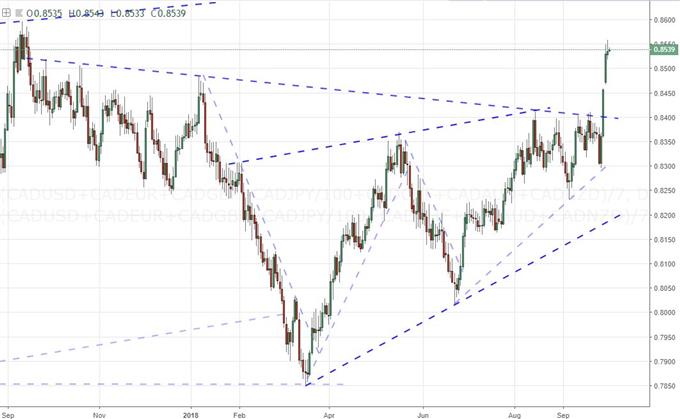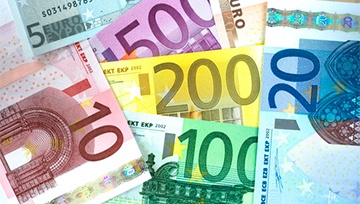Talking Points:
- While the Dow managed to extend its jump to start the week to a fresh record high, few other risk assets were showing enthusiasm
- EURUSD has moved back to a 'shoulder line' on a broader reversal pattern, breaking lower will require stronger motivation
- Oil's breakout has quickly pumped the breaks while Gold finds its own short-term technical charge
What do the DailyFX Analysts expect from the Dollar, Euro, Equities, Oil and more through the 4Q 2018? Download forecasts for these assets and more with technical and fundamental insight from the DailyFX Trading Guides page.
The Trade War Breakthrough Has a Short Half-Life
Only two trading days have passed since the news that the United States and Canada had come to an agreement to break the standoff on their trade war, and yet we are already seeing the confidence it had inspired in the markets drop sharply. The renegotiation of the NAFTA agreement to land on the USMCA represents a definitive break in the clouds and retreat from a specific financial cliff, but that doesn't earn the capital markets boundless optimism. It seems only to translate into recovery of lost speculative ground. Of the three currencies directly involved in the negotiations, the Canadian Dollar was the only one to have a strong reaction to the news immediately after delivery. USDCAD made its break below 1.2900, but there was no follow through to register Tuesday. If we tried to chalk that up to confusion over who benefits the most, an equally-weighted Canadian Dollar index similarly showed a downshift in momentum behind its climb. If that was the downshift from those directly involved, the assets further afield would naturally commit more readily. The Dow managed another stretch to record highs, but most other risk assets would check lower from Monday's swell. Emerging markets, Yen crosses and European indices all showed struggle that signals that response to improvement in the trade wars status will be as restrained as the concern that follows its worsening.

Fears of an Italian-Bred Eurozone Crisis Intense but Restricted
Where drive on the trade wars front has cooled, the influence of the more targeted Euro-area financial strain is still under power. The Euro dropped a fifth straight session through Tuesday with headlines about the intent of Italy's government to pressure European leaders to bend to its demands 'or else' still registering for investors. The question is" how willing is the market to allow fear of what-could-be take control of actions? While the Euro's standings in general are still rather buoyant relative to the past year, the benchmark EURUSD stands at the cusp of an important technical boundary. While most of the market is controlled by participants that pay little heed to charts (central banks, investment funds, corporate banks, etc), they have also eased their exposure and allowed more speculative market participants to dictate short-term decisions. With 1.1500 support representing the 'shoulder' on an inverse head-and-shoulders pattern and generally a more frequented level over many more months, there is heft to the figure. Yet, true fundamental drive could make quick work of the figure. The restriction is of course the lack of a true motivation. Italy represents a great capacity to threaten the Eurozone's stability, but there is deep skepticism that it will get that far - in part owing to the general complacency in the market and specifically the lessons carried over from Greece. Traders shouldn't join in the complacency, but they shouldn't expect the speculative rank to suddenly pay attention either. Beware volatility but be skeptical of trend.

Trading Conditions for the Dollar, Pound, Aussie and Franc the Same
In contrast to the Euro's impressive drive - or even the Loonie's brief jump in attention - we are finding other event risk and themes are struggling to keep the markets attention in other regions and currencies. The Fed's rate hike (and projection for more) just last week is nowhere to be seen in the Dollar's move. Sure, the currency has advanced over the past week, but there is evidence to suggest that is more the indirect response to the Euro's losses than its own improvement. The ISM's service activity report ahead and the run of Fed speak will wade through is important, but ultimately should not be relied upon to develop a clear trend. For the Pound, Brexit headlines continue to cross the wires at a steady tempo; but they more contribute to a lack of clarity rather than prompt for trend. That will remain the case until agreement is struck or the clock runs out - it is unlikely that they just call it a day well before the actual divorce. The RBA rate decision this past session had the capacity to leverage a lasting bull trend for the Australian Dollar but the central bank decided against that spark. Already at a discount, we just await sign that the group is plotting its first rate hike in years from a record low benchmark. As for the Franc's retreat, its at-odds situation with the EU persists, but that wasn't enough to keep the fire going. EURCHF in particular is a complicated pair of weak-versus-weak, but we should watch this still-expensive currency closely.

Key Commodities Gold and Crude Oil Flip Poles for Activity
This week started out as a remarkable story for crude oil. The break for the US-standard WTI contract above $75 signaled a move to highs not seen since November 2014 and a firm control for bulls. Of course, this contract-specific performance was still something of a 'catch up' move relative to the European-favored Brent contract, but both standards were firmly in bull trend. Yet, despite the progress for the energy market, speculative appetites were far from inspired to simply let momentum take over. This past session, both WTI and Brent leveled out at their highs just like so many other risk-leaning assets. The supply-demand pressures are still as oppressive as they were Monday with Iran contributions due to drop another 1.5 million barrels per day, but the market's appetite to register that news has clearly ebbed. Meanwhile, seemingly aloof gold has finally shown a heartbeat. The precious metal charged higher Tuesday and pushed the market up to near-term support around $1,210. What motivates such moves is very important when evaluating the intent for follow through. This move clearly ran astray of typical Dollar and more systemic risk influences. I am dubious of the supposed sway of specific groups affording their own bias or the full weight of large buyers. However, the extreme positioning in speculative interests via the COT's net speculative futures reading likely lays the bedrock for short covering. We discuss all of this and more in today's Trading Video.

If you want to download my Manic-Crisis calendar, you can find the updated file here.







